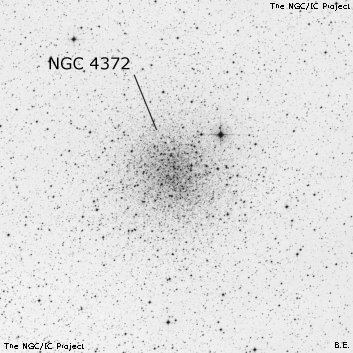NGC/IC Project Restoration Effort
(This is a very very beta version)
NGC4372


Basic Information
Location and Magnitude
Right Ascension: 12:25:45.4
Declination: -72:39:31
Constellation: MUS
Visual Magnitude: 7.2
Historic Information
Discoverer: Dunlop
Year of discovery: 1826
Discovery aperture: 9.0
Observational
Summary description: globular, pF, L, R, st 12…16
Sub-type: XII
Steve's Notes
=====
NGC 4372
24" (4/12/08 - Magellan Observatory, Australia): at 260x, this is a highly-resolved, low-concentration class globular. A mag 6.6 star just 5.5' NW of center is a bit distracting but scores of stars are resolved over the 4' core, appearing to crisscross the center in numerous lanes. The outer halo is very large, nearly 15' in diameter, and resolved into a couple of hundred stars. Except for the brighter and denser core, this globular appears similar to a very large, fully resolved open cluster.
18" (7/6/05 - Magellan Observatory, Australia): at 171x, this large, bright globular was an impressive object and beautifully resolved into 150-200 stars mag 13 and fainter within a 13'-14' diameter. The unresolved background glow was relatively faint for such a well-resolved globular. The large 4' core is only slightly brighter and there is no nucleus (class 12 concentration) although a close pair of brighter mag 12.5 stars is near the center. Scores of stars appear linked in chains and loops, particularly in the outer halo, which is quite irregular and ragged. Mag 6.6 HD 107947 lies 5.5' NW of center at the edge of the halo and provides a striking contrast although it detracts somewhat from viewing. A dust lane appears to pierce the cluster on the north side for a few arc minutes (east of the bright star) and this dark intrusion may be an extension of the "Dark Doodad" (see notes).
18" (7/7/02 - Magellan Observatory, Australia): at 228x, this large, loose globular was well-resolved into ~100 stars mag 12-15 with a 12' diameter. The roundish core is ~4' in size with many faint stars sprinkled across the core. The halo is elongated and irregular in shape. A starless dark lane appears to wind into the cluster towards the core from the NW side angling roughly NW-SE (later verified on the DSS). A mag 6.8 star lies 5' NW of the core and interferes with viewing! Located 44' SW of mag 3.8 Gamma Muscae.



